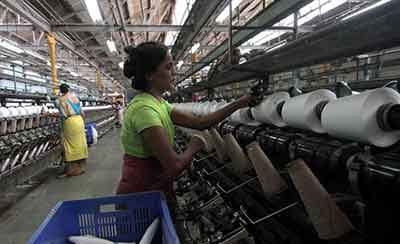Date: 13/02/2023
Relevance: GS-3: Indian Economy and issues relating to planning, mobilization, of resources, growth, development and employment.
Key Phrases: Most favoured nation (MFN), RoDTEP, FTA-led price reduction, FTAs (Free Trade Agreements).
Context:
- The export performance of India’s textiles sector is modest and one of the reasons is high import duties in developed countries.
- For example, the duty in the EU and the UK on most garments imported from India is 12 per cent. The duty in the US may reach 32 per cent.
Key Highlights:
- Indian firms get an immediate price advantage when such duties become zero due to FTAs (Free Trade Agreements).
- Indian firms also get a level playing field with firms from Vietnam and Bangladesh, whose products enter the EU and the US at zero duty.
- Looks certain. But the quantum will depend on how deftly we understand nuances of each market and work out partner-country specific growth strategies.
Experience with Japan FTA:
- Most favoured nation (MFN) duty on apparel in Japan is 10 per cent. Both countries eliminated duties on all apparel from day one of the FTA.
- India expected a jump in exports, but it did not happen. India’s apparel exports during 2007-09 and 2019-21 increased from $121 million to just $197 million.
- Enough research was not done on the requirements of Japanese buyers. Zero duty was thought to be a good enough advantage.
- While buyers from the EU or the US focus on Indian firms being compliant with various laws, the Japanese would concentrate on process improvement at the supplier’s shop floor.
- The Japanese team may call the production manager and ask him to make a product as per the sample supplied, following the prescribed quality rules.
- Since the Japanese market is small, most Indian exporters did not find the business case to meet Japanese requirements.
Steps which can help Boost Exports to Developed Countries post FTA
- Start engaging with buyers now:
- Indian CEOs must start discussing with counterparts how FTA-led duty elimination will allow them to offer better terms.
- A firm assurance from the buyer may lead to investment in expanding capacity in suitable products in advance.
- Set up design studios in partner countries:
- This will enable a direct interface with buyers. Japanese buyers almost insist upon such investments.
- This would be besides regular business promotion events.
- Invest in high-fashion branded apparel:
- 70 per cent of clothing bought by developed countries is made of mixed synthetics. Their share in Indian exports is less than 40 per cent.
- Watch out for new trends:
- For example, Inditex, the Spanish MNC that owns Zara, announced switching to only cotton or cotton viscose cloths by 2025.
- Publicise the FTA benefits:
- This year, many UK apparel brands have increased retail prices citing high inflation while paying at old rates for imports.
- Likewise, many may only pass on the FTA-led price reduction to consumers only if the public is aware.
- Do not incentivise the export of fibre or yarn.
- The drawback or RoDTEP (Remission of Duties and Taxes on Exported Products) benefits allow firms to export at a price lower than domestic.
- This reduces the availability of inputs for high-value-added apparel exports. Remove all incentives from exports of low-value-added inputs.
- Strengthen the weaving and processing segments:
- The yarn sector has large units, while weaving and processing happen in small informal units.
- Not surprisingly, while India is the number one yarn exporter (India 23 per cent share, China 13 per cent) when it comes to fabrics, performance falls (India 6 per cent, China 52 per cent).
- Only large units with the latest technology can meet the quality requirements. Setting up 10 big-scale weaving and processing units could be an annual goal.
- Liberalise labour laws:
- This will free the sector to invest in large units with 1,000 workers or more under one roof.
- Only large units can provide high volumes, consistent quality, and meet compliance requirements. This is the norm in China or Bangladesh for exporting to developed countries.
- In India, factories with more than 300 workers need government permission to fire workers or exit business.
- Allow units to hire and fire with suitable financial safeguards like the firms in the services sector.
- This simple step will increase the share of workers in the organised sector from the current 8 per cent to a far higher level, benefiting both the employer and the workers and increasing output.
Do you know?
- Textiles sector includes all products in the value chain. From fibre, yarn, and fabric to garments.
- While India’s textiles exports to Japan are small, they are sizeable with respect to the US, the EU and other developed country markets.
- In FY22, India exported apparel and made-ups worth $23.8 billion. Of these, 60 per cent of exports went to the US ($8.8 billion) and the EU ($5.4 billion).
- Textile sector accounts for more than two per cent of the total GDP and more than 12 per cent of the manufacturing sector gross domestic product (GDP).
- The sector is also the second largest provider of employment in India, after agriculture.
- India is a largest cotton producer (23%) in the world and has the highest area under cotton cultivation (39% of world area).
Conclusion:
- The suggested actions can help transform the $250 billion textiles sector employing 50 million people and increase exports to developed countries.
- Indian CEOs must start discussing with counterparts how FTA-led duty elimination will allow them to offer better terms.
Source: The Hindu BL
Mains Question:
Q. Why the export performance of India’s textiles sector is modest? Suggest steps which can help boost exports to developed countries post FTA.






















